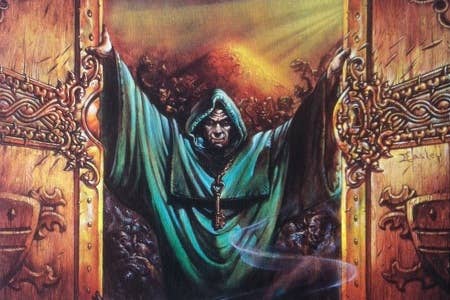Gary Gygax: The Father of Games Design
On the 74th anniversary of Gary Gygax' birthday, Tomas Rawlings looks at the legacy left by the designer of Dungeons and Dragons
"So how do I become a games designer?" is a question I often get asked as I engage with students and gamers in my work. The reply I often give is simple, "Shutdown your PC, switch off your tablet, turn your phone to silent then get hold of a copy of Dungeons & Dragons". Of course I don't mean the various video game versions (great as many of them are) and I don't mean the recent Facebook game (which is also fun). I mean the original rule book plus some pens, paper and loads of dice (don't forget those d20s!). Then, Level 1 Magic User, you will be ready to begin your journey...
Playing Dungeons & Dragons is one of the best ways to learn the foundations of game design. It is how I (and lots of others in the industry) learned about making games. By running Dungeons & Dragons games we had to master a number of key skills including narrative, drama, gameplay balancing and crucially, the all important stats systems. These diverse areas make Dungeons & Dragons a bit of a paradox; at once a geeky stats-fest and yet also the ultimate social game that only works with a group of friends. What makes it a great way to learn about game design also points to why all games developers owe its co-creator and gaming legend, Gary Gygax, a full horn of ale and a lot of thanks.
"I often feel that all we are doing with digital technology is trying to emulate the purity of gameplay that D&D achieved"
Sadly Gary is not with us today. He died back in 2008, aged 69. Gary was a gaming legend. As well as creating Dungeons & Dragons (along with Dave Arneson) then developing the concept into Advanced Dungeons & Dragons, he also founded the company TSR (now owned by Wizard of the Coast) and the Gen Con gaming convention as well as creating/assisting in a number of other game systems such as Chainmail (the forerunner of Dungeons & Dragons) and Lejendary Adventure.
But for me, his most important legacy is Dungeons & Dragons (aka D&D). If you've not played it, its a Role Playing Game (RPG), played by a bunch of friends sat around a table. One person runs the game (the Dungeon Master or DM for short) while the rest take the role of players within the DM's world. The game is moderated by the DM to a framework set by the D&D rule books and rendered in the player's imaginations. D&D is pure social gaming - it is all about the people playing. And D&D is pure multiplayer gaming - it is all about the player's joint interactions. I often feel that all we are doing with digital technology is trying to emulate the purity of gameplay that D&D achieved.
It is also the great-grandfather of much of video gaming. Why? D&D, the product of Gary's rich imagination was based on a key insight to merge character, narrative and stats into a 'game engine'. D&D envisioned a fictional world simulator designed to be played within (and with). This core idea is still the basic framework for so much of today's video games industry. For example D&D has Hit Points and Damage Modifiers, Hit Rolls and Armour Classes - how many other video games, even non-RPGs, have borrowed this combat framework? D&D has progression with character levels, equipment, skills, spells and more. How many games use the various incarnations of levelling up to keep players interested? Tens of thousands. D&D gave roles to the participants via character classes such as Fighter, Magic User, Cleric, Thief and more. How many games use this approach of allowing the player to map their identity into the game? The answer is legion.
When I first learned to code about aged 12 (BASIC on the BBC), the first program I wrote was a character generator for D&D that rolled up the basic stats for a new character; the two were a natural fit. The first collaborative game I worked on (aged around 13) was an attempt at a D&D type RPG with a fellow pupil who could code much better than me. D&D worked as a video game like dwarves work with beards and gold.

D&D was also the seed for much more. The basic world-building structure of D&D was a rich source of inspiration for other games and many other games followed from Gary's template; RuneQuest, Boot Hill, Stormbringer and Call of Cthulhu to name a few. They were always defined in relation to D&D; Call of Cthulhu was like D&D but with less emphasis on the combat and no levelling up. RuneQuest was like it but had a more expansive combat system, and so on.
I have a fairly sizeable collection of RPG games (I know, I know, it's a wonder that I'm not single, much less married. The secret is a Level 3 Charm Spell.) At home, on my book shelf with pride of place is the TSR 2nd edition of Dungeons & Dragons. For all the reasons I've outlined and the hundreds of hours I spent playing the game, I'd like to raise a mug of mead to Gary Gygax; innovator, game designer, geek, star of Futurama and somebody who brought gaming to the millions. Short of eradicating malaria or something like that, it is hard to imagine a better legacy to leave to the world; that being the bringer of such a volume of fun.
Tomas Rawlings is the designer of the geeky RPG game, Call of Cthulhu: The Wasted Land. He is also a games consultant and is producing the Gamify Your PhD project for The Wellcome Trust (where there is still time for developers to sign up).








